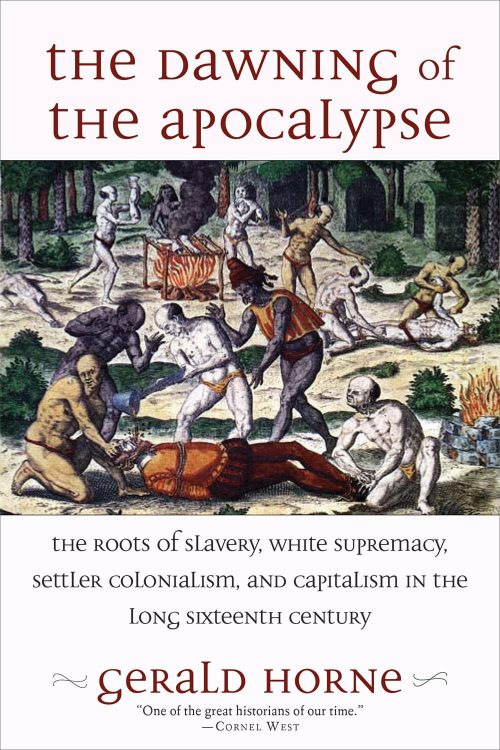The Dawning of the Apocalypse:
The Roots of Slavery, White Supremacy, Settler Colonialism, and Capitalism
in the Long Sixteenth Century
by Gerald Horne
$19.00 paper, 301 pages, 978-1-58367-872-5
Reviewed by Rachel I. Buff for Science & Society
I read this gorgeous, furious book while teaching the first half of the U. S. history survey: 1607–1877. This somewhat vertiginous convergence reframed my understanding of the foundations of this course. Horne rolls back the temporal scope of “Early America,” and in doing so, links the significance of world events during the 16th century to the foundations of imperial, racial capitalism in North America.
Attending to the foundations of white supremacy in the Americas and Europe, Horne convincingly connects the early origins of settler colonialism and slavery, stitching connections between hemispheric histories. As he describes the “apocalypse” of the title: “It is crucial to acknowledge that not only did Western European nations, especially England, rise on the backs of enslaved Africans and dispossessed indigenes, but that this too arrested development on a continental scale” (16).
White supremacy, for Horne, is always “the vanguard of settler colonialism” (147). Many readers will be familiar with Horne’s monumental archival labors in service of resurrecting the history of Black, brown, and broad left-wing movements in the 20th century. In over three dozen monographs, Horne crusades against the deliberate elision of the central role of the communist left in civil rights formations throughout the century. He is a erce critic and skilled opponent of the historical profession’s tendency to blacklist and ignore this crucial past.
In this book as well as its recent antecedent, The Apocalypse of Settler Colonialism: The Roots of Slavery, White Supremacy and Capitalism in 17th Century North America and the Caribbean (Monthly Review Press, 2018), Horne turns to examine the earlier foundations of empire and racial capitalism. Unlike much of his other work, these books are primarily secondary-source–driven.
But Horne is that historian, as skilled in the pyrotechnics of historiographical revision as he is at archival spelunking.
Covering an array of cultural, technological, and military changes, Horne anchors the founding voyages of settler colonialism in the Americas in the global political economy of the 15th and 16th centuries. His approach to the historiography of the old world in this book is as indexical as his combing of archives in others he has written. The resulting narrative incorporates shifting political alliances among European, North African and sub-Saharan powers, as well as technological innovations such as the development of the armaments and nautical vessels that made exploration and conquest possible.
Mapping an interdependent and rapidly transforming world system at the moment of European expansion into the Americas and the transport of enslaved Africans into it, Horne paints a world teeming with religious and political rivalries; with fugitives, adventurers, and entrepreneurs. His account is thematically on point and rich with details. It locates, for example, the origins of the joint stock company, so central to the founding enterprises of British colonialism, in piracy.
Attentive to the consequence and scale of religious rivalries in Western Europe and the Middle East, Horne places crusades against Muslims as a key antecedent to the rise of settler colonial racial capitalism in the Americas; one less-attended strand of this book is the ongoing Islamophobia of Anglo-Protestant political formations. He documents the pillaging of long-accrued Catholic Church riches to penance the eventual ascendance of Anglo-Protestantism in North America. Horne writes: “For it was not just the plunder of rivals that provided London with the primitive accumulation of capital. The ongoing looting of Catholics continued apace” (110).
Horne describes a developing “pan-European” identity rising out of the hot flames of religious conflict over the course of the 16th century. Carried to the Western Hemisphere, this incipient pan-European identity outpaced the rivalries of the old world, replacing them with ascendant white supremacy. Consequently, this book situates the evolution of a broad white identity much earlier than is the scholarly consensus among many contemporary U. S. historians. Focused on the United States, historians like Matthew Frye Jacobson, George Lipsitz, and Dave Roediger attend the evolution of diverse European ethnics into “white” people over the course of the 20th century. These historians build on work by scholars such as W. E. B. DuBois, Kimberlé Crenshaw, and Cheryl Harris on the functioning of whiteness as property.
For this reader, Horne’s more global perspective on issues of whiteness complemented rather than contradicted the presiding scholarly treatments, making the development of white supremacy a long trajectory marked by particular moments of crisis and insurgency. The downside of such a profound reframing, and possibly, the consequence of this book being primarily secondary-source–driven, is the loss of some historical specificity.
In documenting the rise of pan-European whiteness, for example, Horne traces the role of Sephardic Jewish communities fleeing Iberian inquisitions. While the issue of Jewish involvement in the slave trade has occasioned internecine historiographical conflict, Horne parses this charged issue quite sensibly. In his account, Jews in the 16th century appear as both fugitives from persecution and mobile denizens of diasporic networks necessary to their survival. Jewish flight from Spain and Portugal during the Inquisition, as well as their expulsion from England from the 13th through 17th centuries, resulted in the creation of transnational Jewish networks. In the context of European expansion to the Americas, these networks provided important knowledge as well as financial capital for the imperial project of settler colonial apocalypse. Horne places Jews in the Americas as part of emergent pan-European whiteness. While it does elide some of the complexities of anti-Semitism with regards to the formation of whiteness, Horne’s big-picture perspective offers a mostly balanced approach to this particularly vexed question.
Ever attentive to the power and possibility of resistance, Horne documents the significance of collaborations between indigenous nations in the Americas and escaping Africans, in the form of marronage — communities formed of runaway enslaved people, both African and indigenous, often sheltered by local Indian nations — as well as outright rebellion…
Read the rest by heading to Science & Society
In addition to The Dawning of the Apocalypse: The Roots of Slavery, White Supremacy, Settler Colonialism, and Capitalism in the Long Sixteenth Century, Gerald Horne is author of The Apocalypse of Settler Colonialism: The Roots of Slavery, White Supremacy, and Capitalism in Seventeenth-Century North America and the Caribbean, Jazz and Justice: Racism and the Political Economy of the Music, and Confronting Black Jacobins: The United States, the Haitian Revolution, and the Origins of the Dominican Republic, all published by Monthly Review Press.


Comments are closed.